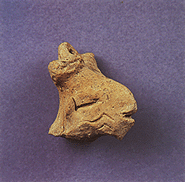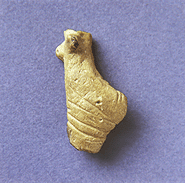 
The study of animal bones, found in great quantities during the excavation of Neolithic settlements, by archaeozoologists, has shown that animal husbandry in the Greek area was based from the beginning of the 7th millenium on five domesticated species: sheep, goats, cattle, pigs and dogs. Sheep ang goats were not domesticated in Greece itself, since in this geographical area their wild forms did not exist during the Palaeolithic and Mesolithic Periods. They became domesticated during the middle of the 8th millenium in the Near East and their presence in the Aegean has been associated with the much debated issue of whether the Neolithic way of production (Neolithization) was introduced or not from the East. On the other hand, the domestication of pigs, cattle and dogs took place in Greece, since wild boars, wild bulls and wolves were present from the Palaeolithic Period. |

Evidence of the in situ domestication of these animals has been confirmed with the parallel discovery in Neolithic settlements of the Greek mainland (Sitagroi, Lerna) of bones of wild, transitional and tame forms of wild boars and cattle. These species were taken to the islands at the end of the 7th and the beginning of the 6th millenium, as is evident from the bone material found at Knossos, dating to the Aceramic Neolithic. Preference for domesticated species of animals differed according to regions and ages. During the early phases of the Neolithic, sheep and goats were preferred, amounting to 65-90% of the total of consumed animals. During the Late Neolithic, the percentage in settlements of the Greek mainland fell to 40-70%, while it was over 80% on the islands until the Final Neolithic. The increase in the consumption of pigs and cattle from the Early Neolithic, especially in the lowlands of the mainland, is partly linked to the growth in the cultivation of types of pulses, rich in plant proteins. Traces of stone tools as well as fractures observed in bones of dogs, suggest that dogs were included in the diet of the Neolithic farmer and stock-rearer. The young age in which animals were slaughtered and their rearing in mixed herds shows that they were raised basically for their meat, while the milk and wool of cattle, sheep and goats was, at least in the early phases of the Neolithic, of secondary importance. The decrease in the consumption of sheep and goats and their slaughter at an older age during the Late and Final Neolithic can be linked to the development of wool weaving. The development of animal husbandry did not exclude hunting as an activity, nor did it restrict fishing, both of which served as supplementary sources of diet during the Neolithic. |